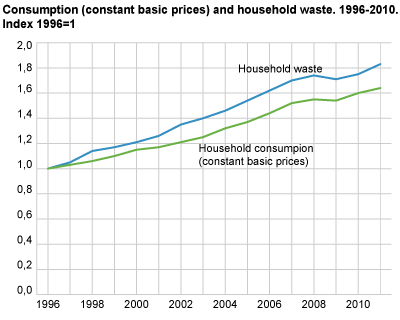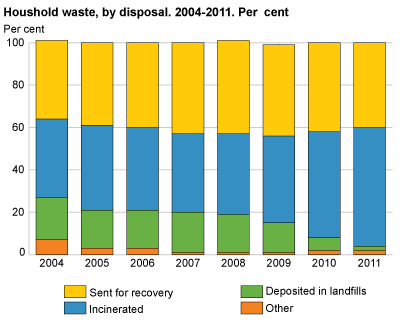Content
Published:
This is an archived release.
Smaller share of waste sent to material recovery
The amount of household waste sent to material recovery was 40 per cent of the total amount of household waste in 2011. In 2008, 44 per cent was sent to recovery.
In total, 2.2 million tonnes of household waste was collected in 2011, and around half of this was sorted and sent to recovery plants.
The figures show that household waste generation increased by 4.5 per cent from 2010 to 2011. This is more than the increase in household consumption, measured in NOK. The figures do not include discarded vehicles and other waste not covered by the municipal waste collection services.
| The whole country | Total | Sent for recovery | |||||||||||||||||||||||||||||||||||||||||||||||||||||||||||||||||||||||||||||
|---|---|---|---|---|---|---|---|---|---|---|---|---|---|---|---|---|---|---|---|---|---|---|---|---|---|---|---|---|---|---|---|---|---|---|---|---|---|---|---|---|---|---|---|---|---|---|---|---|---|---|---|---|---|---|---|---|---|---|---|---|---|---|---|---|---|---|---|---|---|---|---|---|---|---|---|---|---|---|---|
| Total | Kg per inhabitant | Total | Kg per inhabitant | ||||||||||||||||||||||||||||||||||||||||||||||||||||||||||||||||||||||||||||
| 19921 | 1 012 | 237 | 86 | 20 | |||||||||||||||||||||||||||||||||||||||||||||||||||||||||||||||||||||||||||
| 19951 | 1 174 | 269 | 213 | 49 | |||||||||||||||||||||||||||||||||||||||||||||||||||||||||||||||||||||||||||
| 2000 | 1 452 | 324 | 581 | 130 | |||||||||||||||||||||||||||||||||||||||||||||||||||||||||||||||||||||||||||
| 2005 | 1 844 | 401 | 906 | 198 | |||||||||||||||||||||||||||||||||||||||||||||||||||||||||||||||||||||||||||
| 2006 | 1 940 | 414 | 972 | 208 | |||||||||||||||||||||||||||||||||||||||||||||||||||||||||||||||||||||||||||
| 2007 | 2 034 | 429 | 1 037 | 219 | |||||||||||||||||||||||||||||||||||||||||||||||||||||||||||||||||||||||||||
| 2008 | 2 079 | 434 | 1 088 | 227 | |||||||||||||||||||||||||||||||||||||||||||||||||||||||||||||||||||||||||||
| 2009 | 2 039 | 420 | 1 074 | 221 | |||||||||||||||||||||||||||||||||||||||||||||||||||||||||||||||||||||||||||
| 2010 | 2 088 | 424 | 1 110 | 226 | |||||||||||||||||||||||||||||||||||||||||||||||||||||||||||||||||||||||||||
| 2011 | 2 183 | 438 | 1 170 | 235 | |||||||||||||||||||||||||||||||||||||||||||||||||||||||||||||||||||||||||||
| 1 | The figures are scaled down to correct for interference of waste from the industries. |
| Source: Waste statistics, Statistics Norway. | |
More waste is sorted
A total of 1.2 million tonnes of household waste were sorted and sent to recovery in 2011. On average, every Norwegian sorted 235 kg of waste in 2011 compared to 226 kg in 2010.
In this context, sorted and sent to recovery means that the waste is pre-sorted in the households or at the waste disposal plants. After sorting, the waste is normally recycled, composted or incinerated for energy utilisation, but residues from sorting are in most cases disposed of in landfills.
More to incineration
In 2011, around 1.22 million tonnes of household waste were incinerated; an increase of 170 000 tonnes from 2010. Waste sent to material recovery was 9 000 tonnes less than in 2010. The amount of household waste that goes to final disposal has dropped by 10 per cent compared to 2010. Only around 50 000 tonnes of household waste were placed in landfills.
The figures are compiled based on a census conducted by Statistics Norway in all Norwegian municipalities and inter-municipal waste management companies.
Small amounts of waste from Svalbard
The population of Longyearbyen generated on average 216 kg of household waste; less than half of the amount generated by residents in the rest of Norway. Around 41 per cent of the household waste was sorted and sent to recovery.
Tables:
- Table 1 Household waste by county, kg per capita. Percentage waste sent for recovery, including energy recovery. 1995-2011
- Table 2 Household waste sent for recovery, by material. County. 1992-2011. 1 000 tonnes and tonnes
- Table 3 Household waste, by disposal. 1998-2011. 1 000 tonnes
- Table 4 Percentage of inhabitants living in municipalities offering collection at home of sorted waste fractions. 2002-2011
Contact
-
Camilla Skjerpen
E-mail: camilla.skjerpen@ssb.no
tel.: (+47) 48 22 72 14
-
Mona E. Onstad
E-mail: mona.onstad@ssb.no
tel.: (+47) 48 59 61 86


